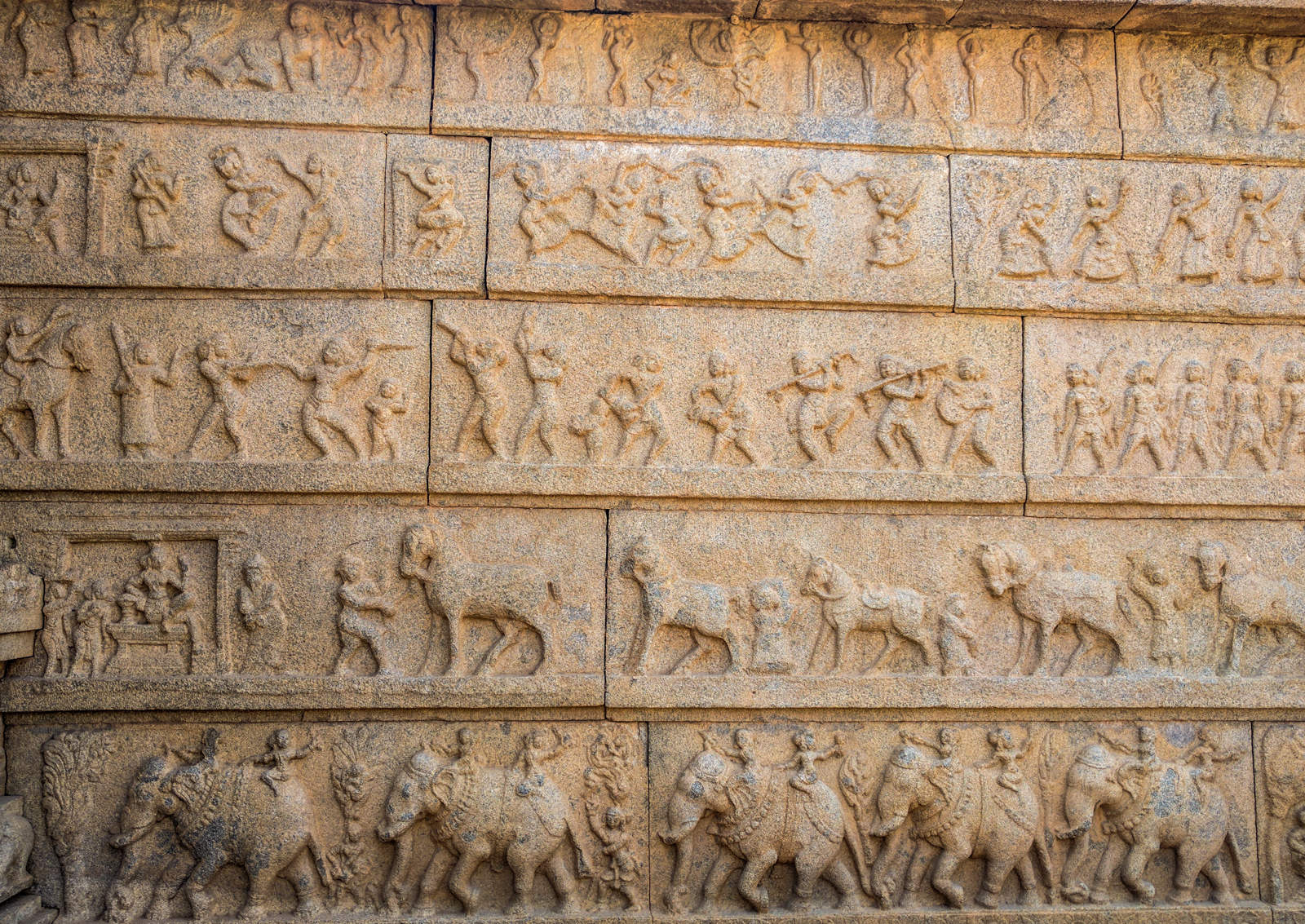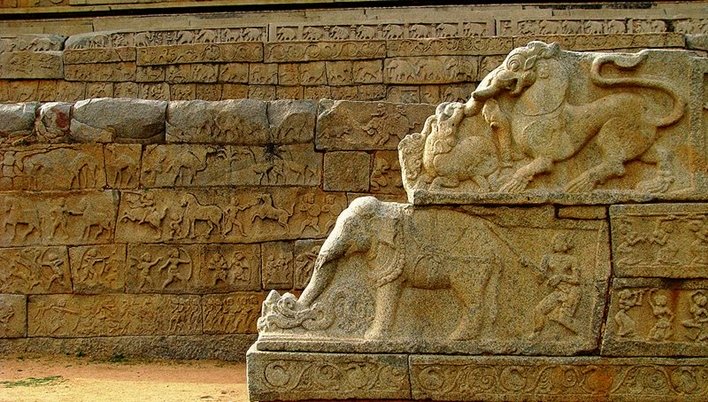Maha Navami-signifying the victory of good over evil
Mahanavami is the earliest known account of this festival being celebrated this way in a grand manner where the residents of the city, Royal family, noblemen and state guests all participated. It is likely that the festival transitioned from a private affair to a grand state affair sometime in the early 15th century. Early we are discussed about another hindu religious festival named 'Mahashivarathri', which you can read from Here.
Maha Navami (Mahanavami) or Durga Navami is celebrated as the victory of good over evil. It is the last day of battle between goddess Durga and demon Mahishasura. Maha Navami begins with Mahasnan (holy bath), followed by prayers to goddess Durga or Maa Durga. It is believed that on Maha Navami goddess Durga is worshipped as Mahisasuramardhini - which literally means the slayer of the buffalo demon or mahishasura.
On Maha Navami, Durga Maa made her final assault on demon Mahishasura, and the following morning, on Vijayadashami, triumphed over him. In fact, Vijayadashami gets derives its name from the Sanskrit and Hindi words Vijaya meaning victorious or triumphant, and Dashami, meaning tenth day. Vijayadashami is also celebrated as Dussehra, which too derives its name from the Sanskrit words Dush meaning bad or evil, and Hara which means defeating or destroying - thereby signifying the victory of good over evil.-(Wiki).
The King of Vijayanagara is fond of displaying their pride, pomp, power and play, in holding every year a stately and magnificent festival, which they call Mahanavami. The King of Bidjanagar (Vijayanagar) directed that his nobles and chiefs should assemble at the royal abode. They brought with them a thousand elephants and were assembled on a broad plain, where they raised enchanting pavilions from two to five stages high, painted with all kinds of figures. Some of these pavilions were so constructed that they revolved.
In front of the plain, a pillared edifice was constructed of nine stories in height, ornamented with exceeding beauty. Between this palace and the pavilions there was an open space beautifully laid out, in which singers and story-tellers exercised their respective arts.
In 1520 CE a portuguese horse trader named Domingo Paes was at Vijayanagara during the reign of Krishnadevaraya. His richly detailed account of Mahanavami festival is by far the most extensive of any foreign visitor to the city.
In 1535 CE, Fernao Nuniz, another Portuguese horse trader, was at Vijayanagara and his writings too document the Mahanavami celebrations. Because of the sheer length of these texts, we decided not to reproduce them in this article, instead we will summarise our observations made based on their original writings.
- The festival of Mahanavami was celebrated over nine days, everyday there would be feasts, animal sacrifices, ceremonies, games of wrestling, archery, entertainment with music & dance. On the last day there was a grand procession in which all the noble houses participated along with Kings own army. After the celebrations the King would take a review of his troops.
- The Kings horses were central to every ceremony during the festival, a role normally fulfilled by elephants in the past. This shows us how much these horses meant to the Vijayanagara Kings. Their success in battle was largely attributed to their horses, which is why they proudly showed them off.
- Nobles and Chieftains from all over the empire came to the capital to pay their due in taxes & pledge their loyalty to the King. With them they brought dancers, wrestlers, archers to represent them and their house in the games. Some of the more powerful chieftains would build elaborate decorated tableau that would participate in the grand Mahanavami procession, representing their dominion.
- During the procession, the Idol of the Goddess Durga is placed on the Lion throne, and the King was seated at its feet. This showed how during the festival the Goddess took primary position in the Kingdom.
- The celebrations continued even after the sun went down, torches were lit around the arena in such a way that it looked as bright as the day. The celebration post sundown included a stunning display of fireworks, rockets, flower pots & bombs.
- The King maintained a fast during all nine days of the festival, the fast was broken at midnight.
- Kings own army took part in the procession with his flag flying high. His fiercest warriors, horses mounted cavalry & archers, and armoured war elephants were all part of it. In 16th century you start seeing musketeers and cannons also be a part of the procession.
- After the nine days of celebrations are completed, the King holds a review of his troops just outside the city. At this review all the weapons are consecrated and blessed by the goddess. The guard of honour includes war drums, trumpets, soldiers shouting, banging their shields, horses and elephants all joining in recreating a battle cry. There are demonstrations of rockets, firemissiles, musket gun shots and cannons.
What ruins of Hampi tell us about Mahanavami
Today if you visit the ruins, you will see many sculptures and structures that were part of the Mahanavami celebrations more than 500 years ago! These Bas-relief sculptures and structures corroborate the written account of how the festival was celebrated.
 |
| Image: Relief Sculptures on the outer wall of Hazara Rama Temple - Depicting the Mahanavami Procession (explorehampi.com). |
The Hazara Rama Temple, located in the center of Urban Core of Vijayanagara, was the Royal temple attached to the palace area of the King. This temple served as the start point for the procession. The outer walls of this temple have stunning relief sculptures that depict the grand royal procession of Vijayadashami or Mahanavami. The sculptures are arranged in five rows, and conceived as continues frieze that is read in a clockwise (right to left) direction. The Bottom row is a long procession of decorated elephants. The second row is procession of riderless horses led by grooms. The third row comprises of a variety of military displays and martial arts. The fourth row shows women entourage dancing, singing and playing musical instruments. Fifth row continues the celebration of dance and music, with scenes of gardens and playing with coloured water.
 |
| Image: Bottom three tiers of Mahanavami Dibba - The great festival platform (explorehampi.com). |
The other important structure that is central to the Mahanavami procession is the great platform called Mahanavami Dibba. This is a three tier pyramidal structure made of granite, it also has some portions made of schist stone. On top of this platform there used to be two tiers hall made of beautifully carved (and decorated) wooden pillars and roof. This structure would house the idol of festival Goddess and the throne of the King during the procession. Today only the bottom three tiers made of stone survive, the outer walls of which are richly carved with bas-relief work representing sculptures of Wrestlers (Garadi or Kusti), Hunters, Horse traders, Camel traders, gymnasts, street acts jugglers, conjurers and illusionists, dancers, instrumentalists, singers, Kings, Door attendants, army chieftains and showcases all the activities of the Mahanavami celebrations.
 |
| Image: Relief Sculptures on the outer wall (bottom three tiers) of Mahanavami Dibba - Depicting the Mahanavami Activities (explorehampi.com). |
Concluding Points
By making the capital epicenter of Mahanavami celebrations in the world, the rulers of Vijayanagara proclaimed to be the protectors of all that is good in the world from evil.
Mahanavami was a martial festival as much as a religious one. The Raya showed off his military might, his weapons, his best warriors, his armoured cavalry and war elephants. Nobleman and chieftains from around the empire gathered every year at the capital city during Mahanavami to pay tributes, provide accounts and pledge loyalty to the the King.
Credits: explorehampi.com

